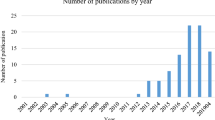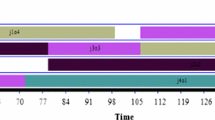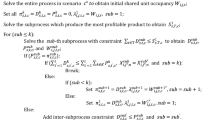Abstract
Generating economical single-part flow-line (SPFL) configurations as candidates for a given demand period is an important optimization problem for reconfigurable manufacturing systems (RMS). The optimization problem addresses the questions of selecting number of workstations, number and type of paralleling identical machines as well as operation setups (OSs) for each workstation. The inputs include a precedence graph for a part, relationships between OSs and operations, machine options for each OS. The objective is to minimize the capital costs of the SPFL configurations. A 0–1 nonlinear programming (NLP) model is developed to handle the key issue of sharing machine utilization over consecutive OSs which is ignored in existing 0–1 integer linear programming (ILP) model. Then a GA-based approach is proposed to identify a set of economical solutions. To overcome the complexity of search space, a novel procedure is presented to guide GA to search within a refined solution space comprising the optimal configurations associated with feasible OS sequences. A case study shows that the best solution derived from the 0–1 NLP model through GA is better than the optimum of existing 0–1 ILP model. The results illustrate the effectiveness of our model and the efficiency of the GA-based approach.
Similar content being viewed by others
Abbreviations
- B&B:
-
Branch-and-bound
- CKSP:
-
Constrained K-shortest path
- DAG:
-
Directed acyclic graph
- DP:
-
Demand period
- FOC:
-
Feasible OC sequence
- FOS:
-
Feasible OS sequence
- GA:
-
Genetic algorithm
- ILP:
-
Integer linear programming
- LP:
-
Linear programming
- NLP:
-
Nonlinear programming
- OC:
-
Operation cluster
- OP:
-
Operation
- OS:
-
Operation clusters setup
- PG:
-
Precedence graph
- RMS:
-
Reconfigurable manufacturing system
- RMT:
-
Reconfigurable machine tool
- SPFL:
-
Single-part flow-line
References
Askin G. R., Zhou M. (1998) Formation of independent flow-line cells based on operation requirements and machine capabilities. IIE Transactions 30: 319–329
Back, T. (1994). Selective pressure in evolutionary algorithms: a characterization of selection mechanisms. In Proceedings of the 1st IEEE Conference on Evolutionary Computation (pp. 57–62), Orlando, FL, USA.
Beale E. M. L. (1965) Survey of integer programming. Operation Research Quarterly 16(2): 219–228
Bi Z. M., Sherman Y., Lang T., Verner M., Orban P. (2008) Development of reconfigurable machines. The International Journal of Advanced Manufacturing Technology 39: 1227–1251
Cooper M. W. (1981) A survey of methods for pure nonlinear integer programming. Management Science 27(3): 353–361
Dolgui, A., Guschinsky, N., & Levin, G. (1999). On problem of opti- mal design of transfer lines with parallel and sequential operations. In The 1999 7th IEEE International Conference on Emerging Technologies and Factory Automation (ETFA’99) (pp. 329–334), Barcelona, Spain.
Dolgui A., Guschinsky N., Levin G. (2006) A special case of transfer lines balancing by graph approach. European Journal of Operational Research 168: 732–746
Dou, J. P., Dai, X. Z., & Meng, Z. D. (2007). Optimization for flow- line configurations of RMS based on graph theory. In 2007 IEEE International Conference on Mechatronics and Automation (IEEE ICMA2007) (1261–1266), Harbin, China.
Dou J. P., Dai X. Z., Meng Z. D. (2009) Graph theory-based approach to optimize single-product flow-line configurations of RMS. The International Journal of Advanced Manufacturing Technology 41(9): 916–931
Fassi I., Wiens G. J. (2000) Multiaxis machining: PKMs and traditional machining centers. Journal of Manufacturing Processes 2(1): 1–13
Fogel D. B. (2000) Evolutionary computation: Towards a new philosophy of machine intelligence. IEEE Press, New York
Garey M. R., Johnson D. S. (1979) Computer and intractability: A guide to the theory of NP completeness. W.H. Freeman, San Francisco
Gen M., Cheng R. W. (2000) Genetic algorithms and engineering optimization. Wiley, New York
Geoffrion A. M., Marsten R. E. (1972) Integer programming algorithms: A framework and state-of-the-art survey. Management Science 18(9): 465–491
Hansen P. (1979) Methods of nonlinear 0–1 programming. Annals of Discrete Mathematics 5: 53–70
Harib K. H., Ullah A. M. M. S., Hammami A. (2007) A hexapod-based machine tool with hybrid structure-kinematic analysis and trajectory planning. International Journal of Machine Tools & Manufacture 47: 1426–1432
Holland J. H. (2000) Building blocks, cohort genetic algorithms, and hyperplane-defined functions. Evolutionary Computation 8(4): 373–391
Katz R. (2007) Design principles of reconfigurable machines. The International Journal of Advanced Manufacturing Technology 34: 430–439
Koren Y., Heisel U., Jovane F., Moriwaki T. (1999) Reconfigurable manufacturing systems. Annals CIRP 48(2): 1–8
Li D., Sun X. L. (2006) Nonlinear integer programming. Springer, New York
Loerch, U. (2000). An introduction to graph algorithms. http://www.cs.auckland.ac.nz/~ute/220ft/graphalg/graphalg.html.
Luenberger D. G., Ye Y. (2008) Linear and nonlinear programming (3rd ed.). Springer, NewYork
Mehrabi M. G., Ulsoy A. G., Koren Y. (2000) Reconfigurable manufacturing systems: key to future manufacturing. Journal of Intelligent manufacturing 11(4): 403–419
Mehrabi M. G., Ulsoy A. G., Koren Y., Heytler P. (2002) Trends and perspectives in flexible and reconfigurable manufacturing systems. Journal of Intelligent manufacturing 13(2): 135–146
Molina A., Rodriguez C. A., Ahuett H. (2005) Next-generation manufacturing systems: Key research issues in developing and integrating reconfigurable and intelligent machines. International Journal of Computer Integrated Manufacturing 18: 525–536
Skiena S. (1998) The algorithm design manual. TELOS-The Electronic Library of Science, Santa Clara, CA
Son, S. Y. (2000). Design principles and methodologies for reconfigurable machining systems. Dissertation, University of Michigan.
Spicer, J. P. (2002). A design methodology for scalable machining systems. Dissertation, University of Michigan.
Syswerda, G. (1989). Uniform crossover in genetic algorithms. In The 3rd International Conference on Genetic Algorithms (pp. 2–9), San Francisco, USA.
Tang, L. (2005). Design and reconfiguration of RMS for part family. Dissertation, University of Michigan.
Ullah A. M. M. S. (2003) Different facets of a computational equivalent of genetic addition. BioSystems 68(1): 31–41
Wiendahl H. P., ElMaraghy H. A., Nyhuis P., Zah M. F., Wiendahl H. H., Duffie N., Brieke M. (2007) Changeable manufacturing—classification, design and operation. CIRP Annals-Manufacturing Technology 56(2): 783–809
Yigit A. S., Ulsoy A. G., Allahverdi A. (2002) Optimizing modular product design for reconfigurable manufacturing. Journal of Intelligent Manufacturing 13: 309–316
Youssef A. M. A., ElMaraghy H. A. (2006) Modelling and optimization of multiple-aspect RMS configurations. International Journal of Production Research 44(22): 4929–4958
Youssef A. M. A., ElMaraghy H. A. (2007) Optimal configuration selection for reconfigurable manufacturing systems. International Journal of Flexible Manufacturing 19: 67–106
Youssef A. M. A., ElMaraghy H. A. (2008) Availability consideration in the optimal selection of multiple-aspect RMS configurations. International Journal of Production Research 46(21): 5849–5882
Author information
Authors and Affiliations
Corresponding author
Rights and permissions
About this article
Cite this article
Dou, J., Dai, X. & Meng, Z. A GA-based approach for optimizing single-part flow-line configurations of RMS. J Intell Manuf 22, 301–317 (2011). https://doi.org/10.1007/s10845-009-0305-7
Received:
Accepted:
Published:
Issue Date:
DOI: https://doi.org/10.1007/s10845-009-0305-7




